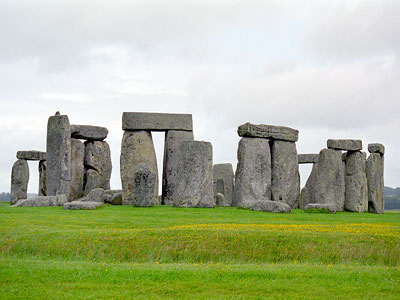Prehistory
Page 1 of 1
 Prehistory
Prehistory
Two thousand years ago there was an Iron Age Celtic culture throughout the British Isles. It seems that the Cells , who had been arriving from Europe from the eighth century BC onwards, intermingled with the peoples who were already there. We know that religious sites that had been built long before the arrival of the Celts continued to be used in the Celtic period .
For people in Britain today, the chief significance of the prehistoric period (for which no written records exist) is its sense of mystery.
This sense find s its focus most easily in the astonishing monumental architecture of this period, the remains of which exist throughout the country. Willshire, in south-western England, has two spectacular examples: Silbury Hill , the large stburial mound in Europe , and Stonehenge (c- Stonehenge) . Such places have a special importance for anyone interested in the cultural and religious practices of prehistoric Britain. We know very little about these practices, but there are some organizations today (for example, the Order of Bards, Ovates and Druids - a small group of eccentric intellectuals and mystics) who base their beliefs on them.

Stonehenge
Stonehenge was built on Salisbury Plain some time between 3050and 2300 BC . It is one or the most famous and mysterious archaeological sites in the world . One of its mysteries is how it was ever built at all with the technology of the time (the stones come from over 200 miles away in Wales). Another is its purpose. It appears to function as a kind of astronomical clock and we know it was used by the Druids for ceremonies marking the passing of the seasons. It has alwa ys exerted a fascination on the British imagination. and appears in a number of novels, such as Thomas Hardy's Tess of the D'Urbevilles. These days Stonehenge is not only of interest to tourists, but is also a gathering point for certain minority groups such as hippies and New Age Travellers . It is now fenced off to protect it from damage.
For people in Britain today, the chief significance of the prehistoric period (for which no written records exist) is its sense of mystery.
This sense find s its focus most easily in the astonishing monumental architecture of this period, the remains of which exist throughout the country. Willshire, in south-western England, has two spectacular examples: Silbury Hill , the large stburial mound in Europe , and Stonehenge (c- Stonehenge) . Such places have a special importance for anyone interested in the cultural and religious practices of prehistoric Britain. We know very little about these practices, but there are some organizations today (for example, the Order of Bards, Ovates and Druids - a small group of eccentric intellectuals and mystics) who base their beliefs on them.

Stonehenge
Stonehenge was built on Salisbury Plain some time between 3050and 2300 BC . It is one or the most famous and mysterious archaeological sites in the world . One of its mysteries is how it was ever built at all with the technology of the time (the stones come from over 200 miles away in Wales). Another is its purpose. It appears to function as a kind of astronomical clock and we know it was used by the Druids for ceremonies marking the passing of the seasons. It has alwa ys exerted a fascination on the British imagination. and appears in a number of novels, such as Thomas Hardy's Tess of the D'Urbevilles. These days Stonehenge is not only of interest to tourists, but is also a gathering point for certain minority groups such as hippies and New Age Travellers . It is now fenced off to protect it from damage.
Page 1 of 1
Permissions in this forum:
You cannot reply to topics in this forum